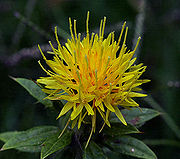
Suetsumuhana
Encyclopedia

Safflower
Safflower is a highly branched, herbaceous, thistle-like annual. It is commercially cultivated for vegetable oil extracted from the seeds. Plants are 30 to 150 cm tall with globular flower heads having yellow, orange or red flowers. Each branch will usually have from one to five flower heads...
. It is known now as .
It is also the name of a female character in Murasaki Shikibu
Murasaki Shikibu
Murasaki Shikibu was a Japanese novelist, poet and lady-in-waiting at the Imperial court during the Heian period. She is best known as the author of The Tale of Genji, written in Japanese between about 1000 and 1012...
's epic novel The Tale of Genji
The Tale of Genji
is a classic work of Japanese literature attributed to the Japanese noblewoman Murasaki Shikibu in the early 11th century, around the peak of the Heian period. It is sometimes called the world's first novel, the first modern novel, the first psychological novel or the first novel still to be...
. The sixth chapter of it is named after her. She is also known as the Safflower Princess. In some English translations she appears as Princess Hitachi. Prince Genji was briefly attracted to her, until she lowered her fan to reveal her nose. However, he eventually felt sorry for her and helped support her.
The incident with the Safflower Princess's nose has always been a source of comic relief for readers of the "Tale of Genji". In the manga
Manga
Manga is the Japanese word for "comics" and consists of comics and print cartoons . In the West, the term "manga" has been appropriated to refer specifically to comics created in Japan, or by Japanese authors, in the Japanese language and conforming to the style developed in Japan in the late 19th...
comics, the extremely shy princess is always depicted as being quite unattractive, the amorous prince having fallen in love first because of her voice and the way she plays the koto
Koto (musical instrument)
The koto is a traditional Japanese stringed musical instrument, similar to the Chinese guzheng, the Mongolian yatga, the Korean gayageum and the Vietnamese đàn tranh. The koto is the national instrument of Japan. Koto are about length, and made from kiri wood...
. The arrangements of her jūnihitoe
Junihitoe
The is an extremely elegant and highly complex kimono that was only worn by court-ladies in Japan. Literally translated, it means "twelve-layer robe". The older term, still used by scholars but not widely recognised in mainstream Japan, is Karaginu Mo...
robes were however described as fitting those of an older lady. (She was hidden in the beginning behind the sudare
Sudare
are screens or blinds. They are sometimes called as well, particularly if they have a green fabric hem. Sudare are made of horizontal slats of decorative wood, bamboo, or other natural material woven together with simple string, colored yarn, or other decorative material to make nearly solid...
screen
Window screen
A window screen, insect screen or bug screen is a metal wire, fiberglass, or other synthetic fiber mesh, stretched in a frame of wood or metal, designed to cover the opening of an open window. Its primary purpose is to keep leaves, debris, insects, birds, and other animals from entering a building...
, however as part of the courtly Heian
Heian period
The is the last division of classical Japanese history, running from 794 to 1185. The period is named after the capital city of Heian-kyō, or modern Kyōto. It is the period in Japanese history when Buddhism, Taoism and other Chinese influences were at their height...
rituals, the 12-layered sleeve
Sleeve
Sleeve is that part of a garment which covers the arm, or through which the arm passes or slips. The pattern of the sleeve is one of the characteristics of fashion in dress, varying in every country and period...
s were allowed to peek from under the screen. Based on the colour-arrangements, the suitor could see what kind of taste and status his lady had.)
Modern scholars however speculate that Suetsumuhana's nose, which was described in the "Genji" as being red and that of an elephant
Elephant
Elephants are large land mammals in two extant genera of the family Elephantidae: Elephas and Loxodonta, with the third genus Mammuthus extinct...
, probably resembles today's European noses. The ideal of female beauty in Heian was to have very fine, thin noses, as depicted in the painted scrolls The Tale of Genji#Illustrated scroll. Anything that fell outside this courtly beauty ideal must have been seen as utterly obscene.

